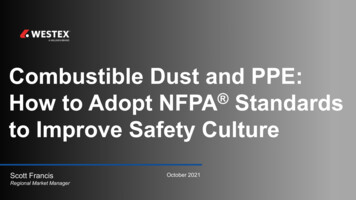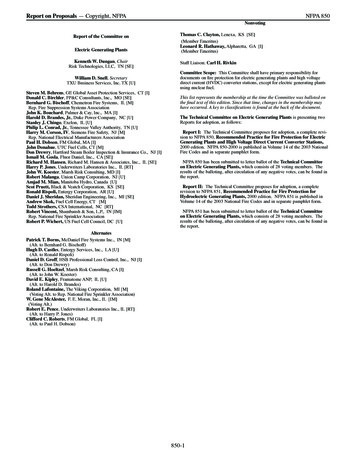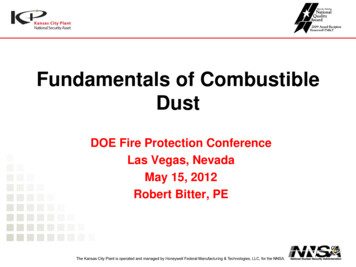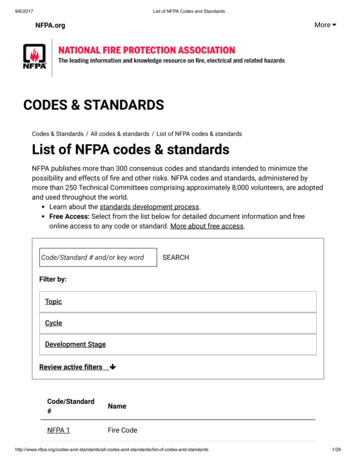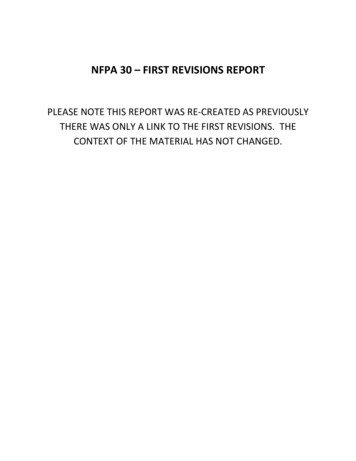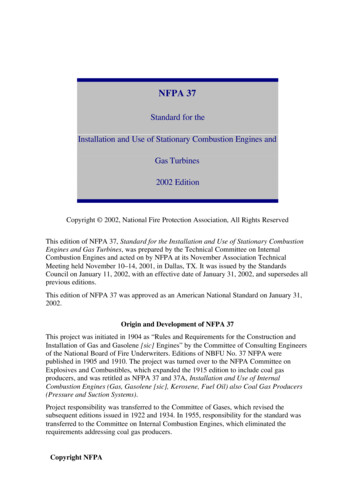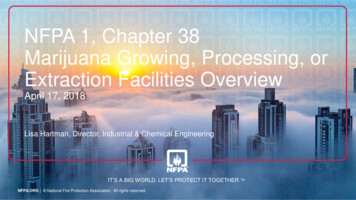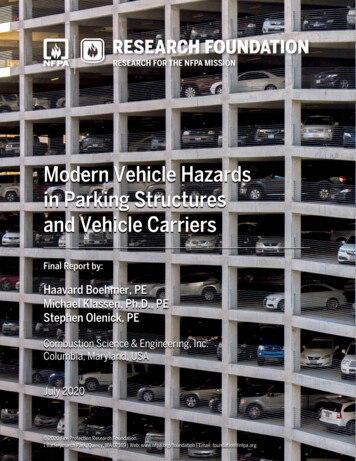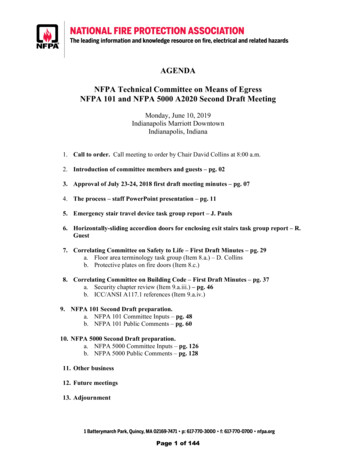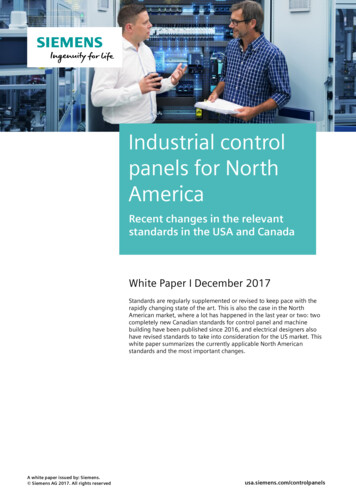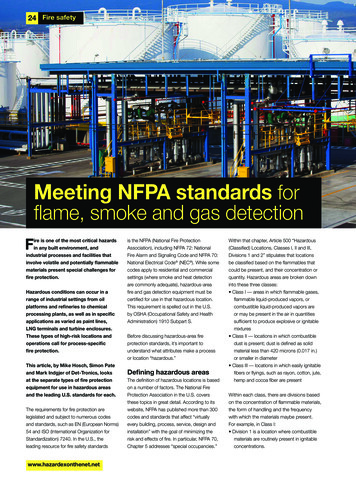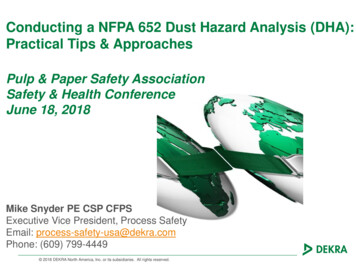
Transcription
Conducting a NFPA 652 Dust Hazard Analysis (DHA):Practical Tips & ApproachesPulp & Paper Safety AssociationSafety & Health ConferenceJune 18, 2018Mike Snyder PE CSP CFPSExecutive Vice President, Process SafetyEmail: process-safety-usa@dekra.comPhone: (609) 799-4449 2018 DEKRA North America, Inc. or its subsidiaries. All rights reserved.
Outline for Today’s Discussion: Introduction Combustible Dust Basics Assessing Flash Fire & Explosion Dust Hazards What Makes a Dust Become a Combustible Hazard? Data & Information for Combustible Dust Classification Conducting a NFPA Dust Hazard Analysis (DHA) New (and Old) Requirements in IFC (2018) Changes in NFPA 652 (2019) Introduce the Table of References Discussion & Questions 2018 DEKRA North America, Inc. or its subsidiaries. All rights reserved.
DEKRA Process Safety:Serving as a TrustedSafety Advisor Integrated Solutions Provider Process Safety Consulting,Engineering and Laboratory Testing Combustible Dust Testing & Analysis Data Management & Analytics Organizational Safety Organizational Reliability(Human Error & Fatigue)For more information:www.dekra-process-safety.com 2018 DEKRA North America, Inc. or its subsidiaries. All rights reserved.
Combustible Dust Hazard Basics 2018 DEKRA North America, Inc. or its subsidiaries. All rights reserved.
Conditions for a Combustible Dust Fire or USPENSION 2018 DEKRA North America, Inc. or its subsidiaries. All rights reserved.
Secondary Explosions Present Additional Risks1PRIMARYEXPLOSIONDUST LAYER2DUST CLOUD FORMEDBLAST WAVE3SECONDARY EXPLOSION 2018 DEKRA North America, Inc. or its subsidiaries. All rights reserved.
Combustible Dust Fire or Dust Explosion?SUSPENSIONRemove the CONFINEMENT Leg Flash FireRemove the SUSPENSION Leg “Regular” FireRemove any other Leg NO Explosion or Fire! 2018 DEKRA North America, Inc. or its subsidiaries. All rights reserved.
Assessing Combustible Dust HazardsCost Effectively Collecting Proper Data 2018 DEKRA North America, Inc. or its subsidiaries. All rights reserved.
Examples of Combustible MaterialsFocus is on particles 500 microns (35 mesh)Source: OSHA Combustible Dust Poster 2018 DEKRA North America, Inc. or its subsidiaries. All rights reserved.
Combustibility / Explosibility of Dusts Determination of combustibility or explosibility shall be permitted to bebased on the following: Historical facility data or published data that are deemed to berepresentative of current materials & process conditions Laboratory analysis of representative samples Permitted to test a sample sieved to 75μm Permitted to test the as-received sample Permitted to assume a material is explosible, forgoing the laboratory analysis Absence of previous incidents shall not be used as basis for deeming aparticulate non-combustible or non-explosibleNote: Test results strongly influenced by particle size, moisture content, presence of contaminants Be sure test results are representative for your material! 2018 DEKRA North America, Inc. or its subsidiaries. All rights reserved.
Typical Combustible Dust TestsTestHazard EvaluatedGo/No Go Test (ASTM E1226)Does the Dust Explode?(with a High Energy Ignition Source)Minimum Ignition Energy (MIE)The energy required to ignite a dust cloudunder fairly ideal conditions.Minimum Explosible Concentration(MEC)The minimum amount of dust(dispersed in air) for an explosion.Maximum Pressure Rise (Pmax) and Dust Explosion Pressure Factors for Designof Containment and Relief SystemsMax Rate of Pressure Rise (Kst)Minimum Ignition Temperature (MIT) Used for Electrical Area Classification andfor Dust Analysis if handled at Elevatedfor Clouds and LayerTemperaturesLimiting Oxygen ConcentrationIgnition prevention below what level ofoxygen (used for inerting system design)Electrostatic ChargeabilityDetermines How Easily a Material Developsand Retains Charge 2018 DEKRA North America, Inc. or its subsidiaries. All rights reserved.
Strategy for Dust Explosion Testing & Implicationsfor Basis of SafetySource:DEKRA Process SafetySAFETY GUIDE:A strategic guide tocharacterization andunderstanding HandlingDusts and Powders Safely 2018 DEKRA North America, Inc. or its subsidiaries. All rights reserved.
An Overview of Dust Hazard Analysis (DHA)Establishing a Basis of Safety 2018 DEKRA North America, Inc. or its subsidiaries. All rights reserved.
Hazard Management: Prevention & MitigationBasis of Safety Avoidance of flammable atmospheres Elimination of ignition sources Provision against consequences of ignitionNO FIREIGNITION SOURCEREMOVEIGNITION SOURCE 2018 DEKRA North America, Inc. or its subsidiaries. All rights reserved.
Managing Combustible Dust Fire and ExplosionHazards Requires Detailed knowledge of: Combustible material properties Process equipment Operating conditions Maintenance practices Existing controls (safeguards) and More These are Generally Collected and Analyzed through aDust Hazard Analysis (DHA), using NFPA 652 2018 DEKRA North America, Inc. or its subsidiaries. All rights reserved.
NFPA 652 Compliance Requirements:A Framework for Dust Hazard Management Owner/operator of facility with potentially combustibledust shall be responsible for: Determining combustibility and explosibility hazards of materials(Chapter 5) Conducting a Dust Hazard Analysis (DHA) - Identifying and assessingfire, flash fire, and explosion hazards (Chapter 7) Managing identified fire, flash fire, and explosion hazards Prescriptive Approach (Chapters 5, 7, 8, 9) It shall be permitted to use performance-based alternative designs for abuilding, equipment, ignition source control, and explosion protection inlieu of prescriptive requirements in Chapter 8 (Chapter 6) Establishing Safety Management Systems (Chapter 9) 2018 DEKRA North America, Inc. or its subsidiaries. All rights reserved.
Conducting a Dust Hazard Analysis (DHA):Methodology Identification and evaluation where Fire, Flash Fire, andExplosion Hazards Exist When these Hazards Exist, Identification and Evaluation ofSpecific Fire and Deflagration Scenarios: Identification of Safe Operating Ranges Identification of Safeguards that are in place Mitigation and Prevention Measures in Chapter 8 Aligned with Recognized and Generally Accepted Good EngineeringPractices (RAGAGEP) Recommendation of additional safeguards when warranted,including plan for implementation 2018 DEKRA North America, Inc. or its subsidiaries. All rights reserved.
Conducting a Dust Hazard Analysis (DHA):Evaluation Process Systems When Combustible Dust is Present: Oxidizing Atmosphere Credible Ignition Sources Suspension Evaluation of Dust & Deflagration Propagation between Units Building and Building Components Prevention of Fugitive Emissions Dust Collection Housekeeping Hazardous Area (Electrical) Classification NFPA 499, Tables A 6.3.2(a) and A 6.3.2(b) 2018 DEKRA North America, Inc. or its subsidiaries. All rights reserved.
Control of Combustible Dust Atmospheres(Control of Fugitive Emissions) Equipment should be maintained and operated in amanner that minimizes the escape of dust Continuous local exhaust ventilation should be provided for processeswhere combustible dust is liberated in normal operation so as tominimize the escape of dust. The dust should be conveyed to dust collectors Regular cleaning frequencies should be established for floors andhorizontal surfaces, such as ducts, pipes, hoods, ledges, and beams, tominimize dust accumulations within operating areas of the facility (1/32inch; 0.8 mm – with adjustments) Warning Indicators that your Dust Accumulations are too large: Can you tell the color of the surface below the dust? Can you write your name in the dust? 2018 DEKRA North America, Inc. or its subsidiaries. All rights reserved.
The Important Role ofDust Collectors Prevents Dust Accumulations Collection & Removal of Fugitive Dusts Controls Fugitive Dust Accumulations Key Design Considerations Adequate Air Transport Velocity in Ductwork Need to Prevent Dust Settling & Accumulation Proper Design (and Direction) of Explosion VentingTypically Installed OutdoorsSpecific design features required to recirculate airNever Store Dust in the Hopper 2018 DEKRA North America, Inc. or its subsidiaries. All rights reserved.
NFPA 652 (Chapter 9): Management Systems Operating Procedures &Practices Incident Investigation Inspection, Testing, &Maintenance Documentation Retention Training & HazardAwareness Management ofContractors Emergency Planning &Response 2018 DEKRA North America, Inc. or its subsidiaries. All rights reserved. Management of Change Management SystemReview Employee Participation
Implications of International Fire Code (2018) onCombustible Dust Operations 2018 DEKRA North America, Inc. or its subsidiaries. All rights reserved.
Sources of Requirements for ManagingCombustible Dust OSHA CPL 00-03-08 – Combustible Dust NEP Non-Regulatory Requirements Insurance Company Standards (e.g. FM Global) NFPA Codes & Standards Building & Fire Codes Typically Adopted at Local & State LevelApplied for Issuance of Building PermitsRoutine InspectionsPost-Incident 2018 DEKRA North America, Inc. or its subsidiaries. All rights reserved.
Regulatory Landscape:International Fire Code 2018 DEKRA North America, Inc. or its subsidiaries. All rights uploads/Code Adoption Maps.pdf
What is an Occupancy Classification? A classification of buildings and structures that manages theuse and occupancy To provide a rationale criteria that is relative to fire hazardand life safety considerations Implications on Building Construction, Size, & Layout Typical Classifications Group F: Factory Industrial Group S: Moderate- and Low-Hazard Storage Group H: High Hazard 2018 DEKRA North America, Inc. or its subsidiaries. All rights reserved.
International Fire Code (2018) Group H Occupancy Classification Uses Tables in Chapter 50, Section 5003 General Rule based on “Exempt Amounts” for Storage & Use. Amounts Greater than these levels become Group H Adjustments allowed for Sprinkler Protection Combustible Dust Classification (2012) No “Exempt Amounts” Dust Manufactured or Used in a Fashion Presenting a Fire orExplosion Hazard (Table 5003.1.1(1)) Occupancy Group H2 Classification Engineering Evaluation in Section 104.7.2 is required to quantitativelydocument risk analysis to not classify as Group H2 2018 DEKRA North America, Inc. or its subsidiaries. All rights reserved.
Chapter 22:Combustible Dust-Producing Operations Existing Requirements Forced air or similar methods shall not be used to remove dustfrom surfaces More stringent than existing NFPA requirements Operational permits required for operations producingcombustible dusts, such as flour mills and grain elevators New Requirements in 2018 Edition Dust Hazard Analysis Required (NFPA 652) 3 Year Implementation Cycle Explosion Protection per NFPA Industry- or Commodity- SpecificStandards 2018 DEKRA North America, Inc. or its subsidiaries. All rights reserved.
Introducing NPFA 652 (2019) 2018 DEKRA North America, Inc. or its subsidiaries. All rights reserved.
NFPA 652 (2019):Updates & Changes Issued as Consent Document (April 2018) Changes to DHA Timelines DHA must be completed for Existing Processes by Sept 7, 2020 2 Year Extension from NFPA 652 (2016) 5 Year Revalidation Schedule Coordination with other NFPA Dust Standards 2020 Edition of NFPA 654 proposes same Deadline 2020 Editions of NFPA 61 and 664 have not yet had First DraftMeetings Rearrangement of Chapter 8 & Chapter 9 Hazard Management: Mitigation & Prevention Management Systems 2018 DEKRA North America, Inc. or its subsidiaries. All rights reserved.
ReferencesSources of Recognized and Generally AcceptedGood Engineering Practices (RAGAGEP) 2018 DEKRA North America, Inc. or its subsidiaries. All rights reserved.
References (with Free Access) National Fire Protection Association (NFPA) NFPA 652 (2016), Standard on the Fundamentals of Combustible Dust. NFPA 654 (2017), Standard for the Prevention of Fires and Dust Explosionsfrom the Manufacturing, Processing, and Handling of Combustible ParticulateSolids. NFPA 499 (2017), Recommended Practice for the Classification of CombustibleDusts and of Hazardous (Classified) Locations for Electrical Installations inChemicals Process Areas. NFPA 68 (2018), Explosion Protection by Deflagration Venting NFPA 69 (2014), Standard on Explosion Prevention Systems NFPA 61 (2017), Dusts in Agricultural and Food Processing Facilities NFPA 484 (2015), Standard for Combustible Metals NFPA 655 (2017), Standard for Prevention of Sulfur Fires and Explosions NFPA 664 (2017), Dusts in Wood Processing and Woodworking Facilities 2018 DEKRA North America, Inc. or its subsidiaries. All rights reserved.
References (with Free Access) OSHA Dust Resources OSHA Combustible Dust National Emphasis Program Firefighting Precautions at Facilities with Combustible Dust FM Global FM Global, Data Sheet No. 7-76, Prevention and Mitigation ofCombustible Dust Explosions and Fire (2017 Edition). United Kingdom Health & Safety Executive Safe handling of combustible dusts: Precautions against explosions DEKRA Process Safety SAFETY GUIDE : A strategic guide to characterization andunderstanding Handling Dusts and Powders Safely 2018 DEKRA North America, Inc. or its subsidiaries. All rights reserved.
DEKRA Process SafetyTrusted Advisors for Process Safety ExcellenceThank you for Participating in Today’s r@dekra.com609-799-4449 2018 DEKRA North America, Inc. or its subsidiaries. All rights reserved.
DEKRA Process SafetyWe help our clients to adapt PSM to their needs &to build internal PS competenceConsultingProcess Safety Engineering-Dust Flash Fire & Explosion HazardsGas & Vapor Flammability HazardsElectrostatic HazardsChemical Reaction HazardsProcess Safety Management- Program Implementation &Improvement- Gap Analysis- Process Hazard Analysis- Quantitative Risk Assessments- Consequence Modeling- Incident InvestigationsLaboratory Testing-Combustible Dust Fire & ExplosionGas & Vapor FlammabilityThermal InstabilityChemical ReactivityStatic ElectricityDOT & UN Transportation ofHazardous Materials- Explosivity / Energetic Materials- Customized & Large-Scale Testing 2018 DEKRA North America, Inc. or its subsidiaries. All rights reserved.Competence Development- Courses Covering all Key Aspects ofProcess Safety- Continuing Education Units (CEU’s)- Multiple Languages- Multimedia- Instructor-Led Content- Computer-Based Training
OSHA Dust Resources OSHA Combustible Dust National Emphasis Program Firefighting Precautions at Facilities with Combustible Dust FM Global FM Global, Data Sheet No. 7- 76, Prevention and Mitigation of Combustible Dust Explosions and Fire ( 2017 Edition). United Kingdom Health & Safety Executive
